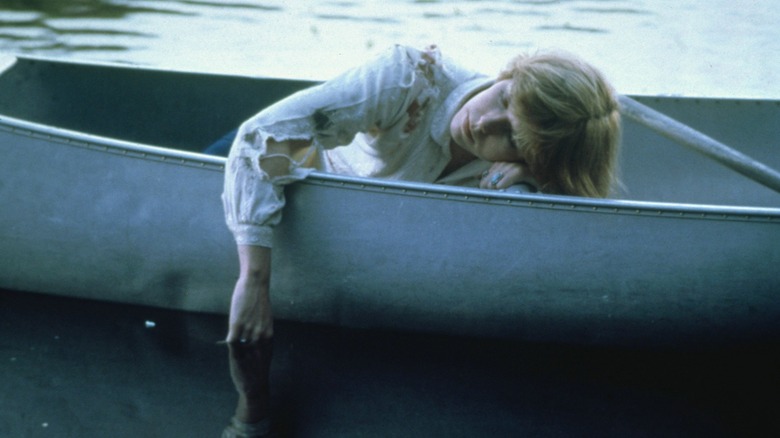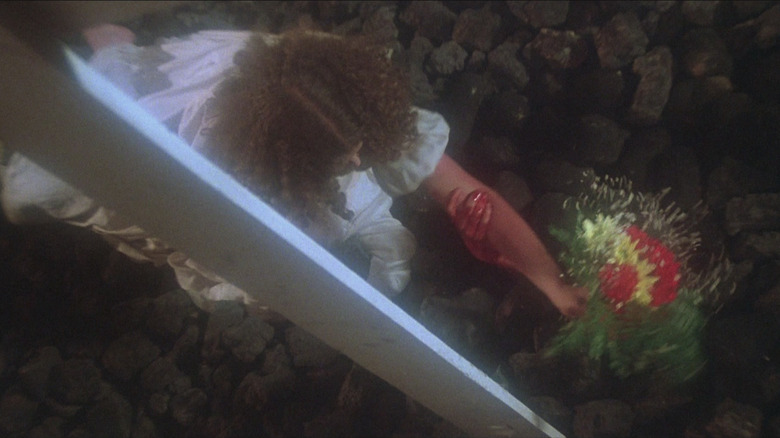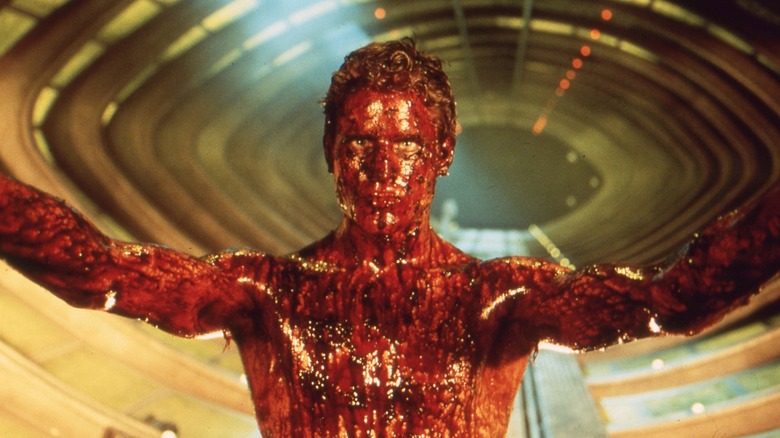Why Carrie Played An Important Role In Creating The Ending For Friday The 13th
Sean S. Cunningham's "Friday the 13th" was not a novel undertaking. It was rushed into production to capitalize on the slasher craze kicked off by John Carpenter's "Halloween," and, aside from the highly telegraphed reveal of Betsy Palmer's Pamela Voorhees as the murderer, seemed content to be a shoddily staged, set-'em-up-and-knock-'em-down horror flick stocked with a few decent kills – none more memorable than the climactic decapitation of Mrs. Voorhees.
By this point in the film, Cunningham had delivered on the meagerest of expectations. Roll credits right there, and your target audience goes home satisfied. But the film's makeup effects maestro, Tom Savini, felt something was missing. He'd recently watched Brian De Palma's "Carrie," and recalled how the final scare, where Sissy Spacek's bloody hand unexpectedly bursts through the charred remnants of her house to grab Amy Irving's wrist, had moviegoers screaming as the lights went up. That's how you end a horror movie.
Since "Friday the 13th" was unabashedly mimicking the "Halloween" formula, why not rip off De Palma for good measure, especially since many critics were accusing the provocateur filmmaker of lifting liberally from Alfred Hitchcock?
Leave 'em screaming
According to Savini, the dream sequence at the end of "Friday the 13th" was initially just a throwaway scene. But what worked for "Carrie" would surely work for his film as well. As he told The New York Daily News, "[W]e thought that we need a 'chair jumper' like that, and I said, 'Let's bring in Jason.'"
Obviously, the likelihood of Jason Voorhees stirring to life to take revenge on the camp counselor who just killed his mother, after chilling for 20-plus years at the bottom of Camp Crystal Lake, is exactly nil. You can explain it away as a dream, but poor Adrienne King is absolutely convinced Jason is still out there — and, as we'd learn a year later in "Friday the 13th Part II," she's absolutely right. Fortunately, "Friday the 13th" is such a preposterously stupid movie that no one cared about the unreality of it. Subsequent directors took full advantage of this, which is why it remains one of the most shamelessly entertaining slasher franchises of all time.
The art, or lack thereof, of the Carrie ending
As to the "Carrie" ending (which was itself inspired by the creepy, hand-rising-out-of-the-river conclusion of John Boorman's "Deliverance"), if you've watched a lot of horror movies from that era, you know that the dream-ending fakeout became a groaner of a cliche. Don Coscarelli worked a nifty twist on it with 1979's "Phantasm," while De Palma deployed it once again for the finale of "Dressed to Kill" (which hit theaters a month after "Friday the 13th"). Ultimately, the device became so overused that it was parodied in Bruce Kimmel's 1983 "Alien" parody, "The Creature Wasn't Nice" (aka "Spaceship").
The gimmick has never really gone away, and it hasn't gotten any fresher. 21 years after the release of "Carrie," Paul W.S. Anderson trotted it out for the conclusion of "Event Horizon," and the reaction I experienced at the Loews Astor Plaza Theatre on opening night was less a "chair jumper" than a "popcorn thrower." Anderson's mistake was in delivering a movie that was a touch too smart for such a trite wrap-up.
So let this be a lesson to aspiring horror filmmakers. Unless you've got a fresh spin, the "Carrie" ending is a terrific way to inform your audience that you do not in any way respect their intelligence. Rather than leaving the theater on a high, they'll walk to their car hating your guts.


